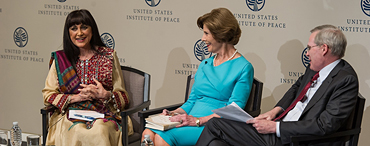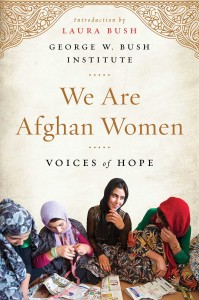
Afghan Women Are Impacting Communities and Culture
By Lynn O’Connell, DFW Member
We Are Afghan Women: Voices of Hope is the title of the book released just last month from the George W. Bush Institute. I had an opportunity to attend an event announcing the book’s publication in Washington, DC, hosted by the United States Institute of Peace which featured a discussion by Laura Bush, former U.S. First Lady, and Mina Sherzoy, a Council member of the U.S.-Afghan Women’s Council.
Politics aside, the event and the facts highlight the tremendous impact that women themselves, as well as funders who support women’s education and self-sufficiency, have on communities and cultures.
- Afghan girls’ enrollment in school is now about 3 million.
- 36% of Afghanistan’s teachers are female.
- Women run an estimated 3,000 businesses in Afghanistan.
 The book tells the stories of 28 Afghan women. There is Sakena Yacoobi, Ph.D., who ran underground schools for girls during the Taliban rule, and now has centers across Afghanistan teaching women and girls basic literacy. (The literacy rate is around 37% for Afghan women.) Masooma Jafari launched a national midwives association to help educate women and make births safer. Naheed Farid is the youngest female member of Afghanistan’s Parliament (there are 28 female members in all); during her campaign, opponents cut her face out of the campaign posters but her husband and father-in-law stood by her all the way through her election.
The book tells the stories of 28 Afghan women. There is Sakena Yacoobi, Ph.D., who ran underground schools for girls during the Taliban rule, and now has centers across Afghanistan teaching women and girls basic literacy. (The literacy rate is around 37% for Afghan women.) Masooma Jafari launched a national midwives association to help educate women and make births safer. Naheed Farid is the youngest female member of Afghanistan’s Parliament (there are 28 female members in all); during her campaign, opponents cut her face out of the campaign posters but her husband and father-in-law stood by her all the way through her election.
It was particularly interesting to hear Mina Sherzoy’s comments and her perspectives on needs:
“Teach our women something so they can earn money. When women have income, there’s both a decline in domestic violence and they get decision-making rights in their families. Women with jobs who can provide money and food for their children is a way to make lives better for entire communities.” – Mina Sherzoy, U.S.-Afghan Women’s Council.
Some takeaways from the event:
- Support for women’s and girls’ education is critical.
- Non-governmental organizations (NGOs) often come in with their own ideas and without doing an assessment of both women’s needs and women’s “wants”.
- Self-sufficiency and jobs are the key training needed – don’t think about other training yet in Afghanistan. Until women have income, other training can be unrealistic and purely aspirational.
- There is a particular need to focus on specialized skills training and on nontraditional occupations (e.g., if possible, on jobs that pay more).
- There are many training programs, but few currently provide data on whether the women got a job and/or the intended job.
- The involvement of men is critical, particularly to get male leaders, teachers, and Imams supportive of women’s education and income-earning. (Example: There are a few women attorneys who defend some domestic violence cases. The cases usually lose, and these women attorneys generally suffer from domestic violence themselves. The perceived need is to start working in the law schools with the women and men who will be the attorneys, judges and law professors in the future.)
For me, my key takeaway – beyond inspiration – was that, yes, as DFW members we are making a significant difference and improving women’s lives, and creating sustainable change for generations to come.
Photo credit: United States Institute of Peace website
